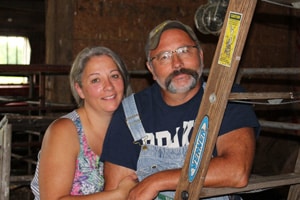JULY 2018
New project helps farmers share stories, safety messages
Scott Heiberger
Communications Specialist
National Farm Medicine Center
 Tell a story, save a life.
Tell a story, save a life.
That’s the idea behind a new project inserting injury prevention messages into first-hand accounts of farmers and others impacted by agricultural trauma incidents.
Telling the Story Project is a collaboration of three regional agricultural safety centers funded by the National Institute for Occupational Safety and Health (NIOSH).
“Farmers tend to be more open to safety messages after reading about a real incident,” said Scott Heiberger, communication manager at the National Farm Medicine Center and a project collaborator.
“Although statistics are important in influencing attitudes and changing behaviors, Telling the Story Project makes safety personal.”
Telling the Story Project content is meant to be shared.
Farmers, media professionals, teachers, Extension, and safety professionals are especially encouraged to link to the stories and repurpose content. Terms of use for republishing and crediting are explained at www.tellingthestoryproject.org/use-our-stories.
Participating centers include Great Plains Center for Agricultural Health (Iowa); Central States Center for Agricultural Safety and Health (Nebraska); and Upper Midwest Agricultural Safety and Health Center (Minnesota).

The project was announced June 26 in Halifax, Nova Scotia, during the International Society for Agricultural Safety and Health annual conference.
The first batch of multi-media stories address manure gases, ATVs, entanglements, falls, ladder failures, flash fires and a common cause of trauma – taking a shortcut.
- Leon, who was engulfed in a fire ball in his swine finishing building, burning 20 percent of his body and melting his glasses. “I heard a WHOOM and a BOOM.”
- Mike, who succumbed to hydrogen sulfide gas after he began agitating manure in the open-air lagoon at his family’s cattle feeding operation, a fatality case so rare it was written up in a peer-reviewed science journal.
- Roxanne nearly lost her husband, Jason, to hydrogen sulfide gas when he was pumping liquid manure from a hog confinement building. “You don’t hear about this happening,” she said. “If you do, it’s because someone died, not because somebody lived.”
- Brian was 8 years old when he lost his entire left arm after it was pulled into the auger of a grinder-mixer. Working with a missing limb makes Brian more susceptible to injury, and he has to work that much harder; these factors inspire him to be proactive about making safety adaptations.
- Kenny heard his thigh bone snap when he rolled the ATV. “Nobody’s gonna look for me,” he thought. For the next five hours, he inched his way up the hill on arms and elbows.
- Rick did something he would never have done if someone had been watching him: he climbed on the top step of a 10-foot stepladder while stretching to replace a light bulb. He fell hard to the concrete when the ladder’s side rail broke, breaking his ribs.
The common thread in the stories:
“We don’t want this to happen to anyone else.”
 Stephanie Leonard, occupational safety manager at Great Plains Center for Agricultural Health, has written most of the articles. Her rapport with farmers and previous position as director of the Iowa FACE (Fatality Assessment and Control Evaluation) Program give her a unique perspective and access into farmers and their workplaces.
Stephanie Leonard, occupational safety manager at Great Plains Center for Agricultural Health, has written most of the articles. Her rapport with farmers and previous position as director of the Iowa FACE (Fatality Assessment and Control Evaluation) Program give her a unique perspective and access into farmers and their workplaces.
“Farmers tell me they want to know the facts when they learn about an accident or death,” Leonard said. “In Telling the Story Project, we want to share that information in a way that’s honest and personal, and that includes the ‘how and why’ these injuries happened, and how they impacted people, even months or years later. The experiences of our storytellers stick with you, and I hope they are shared and passed along to help others recognize unsafe situations. They’re great teachers, and we include safety resources that augment their compelling messages.”
Telling the Story Project partners with ag media on some projects for original publishing, including Iowa Farmer Today’s monthly Safety Watch column. For inquiries regarding use or publication of Rick Friday’s cartoons used by Telling the Story Project, contact Friday directly at www.fridaycartoons.com/contact/.
